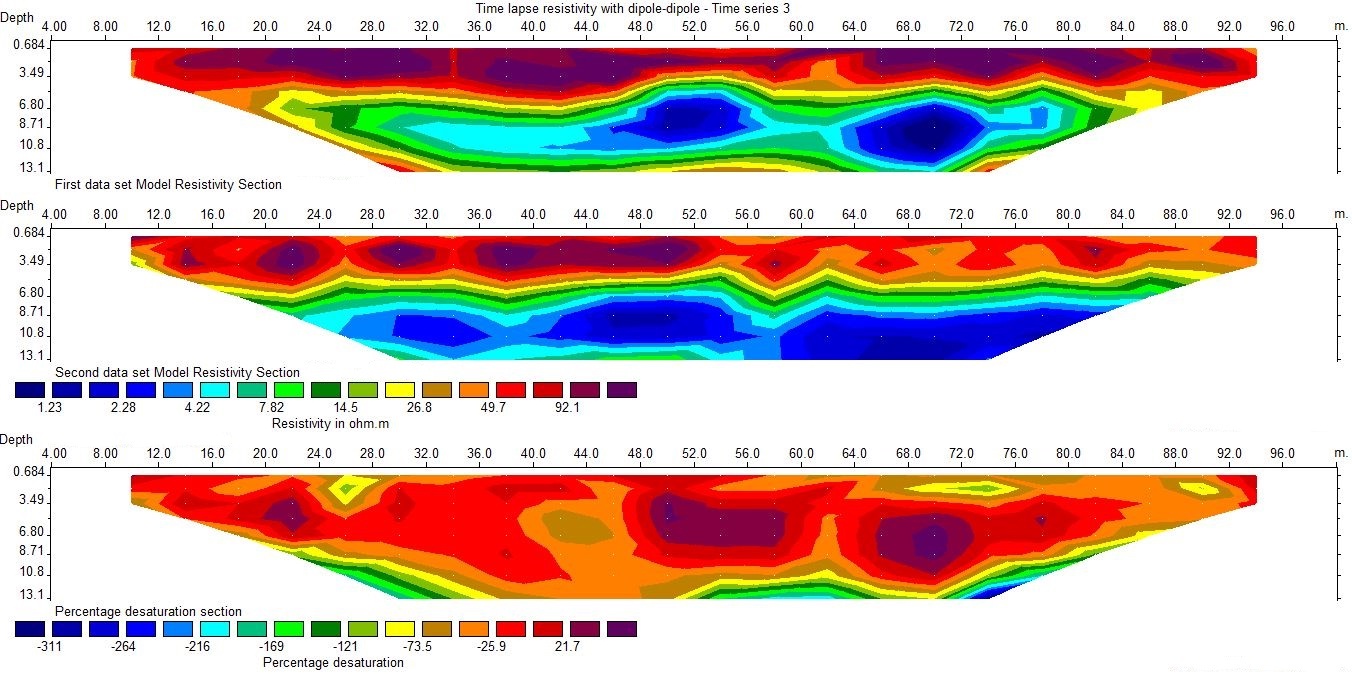Simulation of Time-Lapse Resistivity Method on Sandbox Model to Determine Fluid Changes and Desaturation
DOI:
https://doi.org/10.25299/jgeet.2020.5.4.4266Keywords:
Time-lapse resistivity, Electrical Resistivity Tomography, Sandbox modelAbstract
Time-lapse resistivity method is an implementation of the resistivity method that is executed exactly at the same spot but with various in time. In this study, the technique uses to identify the dynamics of groundwater fluids. The application of the time-lapse resistivity method was carried out by performing a sandbox model simulation that contains layers of rocks with a fault structure. The rock layers consist of tuff, fine sandstone, shale, coarse sandstone, gravel that represents confined and unconfined aquifers. The simulation was achieved by applying the Electrical Resistivity Tomography (ERT) dipole-dipole configuration at the same place, and measurements with 3 different conditions, namely dry, wet conditions filled with 2.5% water and wet conditions filled with 5% water. Data acquisition uses Naniura resistivity meters with a track length of 96 cm. The first measurement results (dry conditions) obtained a range of resistivity values from 3.7 to 168.1 Ω.m, the second measurement (wet conditions filled 2.5% water) obtained the range of resistivity values from 3.3 to 110.8 Ω.m and the third measurement (wet conditions) filled with 5% water the resistivity values range from 1.7 to 91.2 Ω.m. Following the results of time-lapse inversion processing, a larger percentage change in the amount of 5.6% due to water absorption by the surface which then migrates into the inner layer. Whereas the percentage of desaturation ranges is from -3.11 to 0.217 %, refer to Archie’s Law assumes conduction is caused by water content.
Downloads
References
Comina, C., Giordano, N., Ghidone, G., Fischanger, F., 2019. Time-lapse 3D electric tomography for short-time monitoring of an experimental heat storage system. Geosci. 9.
Everett, M.E., 2013. Near-Surface Applied Geophysics, First. ed. Cambridge University Press, New York.
Geotomo Software, 2010. RES2DINV ver. 3.59 - Rapid 2-D Resistivity & IP inversion using the least-squares method Wenner (α,β,γ), dipole-dipole, inline pole-pole, pole- dipole, equatorial dipole-dipole, offset pole-dipole, Wenner-Schlumberger, gradient and non-conventional arrays.
Heyrovska, R., 2011. Partial Dissociation and Hydration Quantitatively Explain the Properties of Aqueous Electrolyte Solutions and hence Empirical Activity Concepts are Unnecessary. Nat. Preced. 1–21.
Inim, I.J., Udosen, N.I., Tijani, M.N., Affiah, U.E., George, N.J., 2020. Time-lapse electrical resistivity investigation of seawater intrusion in coastal aquifer of Ibeno, Southeastern Nigeria. Appl. Water Sci. 10, 1–12.
Kurniawan, A., Tri Nugroho, A., Hermawan, A., Bagus Ari P, Y., Aryo Wibowo, D., Nahara S, Q., H, Nova, H., Darumaya, 2010. Identifikasi Kualitas Air Berdasarkan Nilai Resistivitas Air. Masy. Ilmu Bumi Indones. 1, 15.
Kuswanto, A., Garinas, W., Zikri, S., 2018. Proses Pengambilan Data Dan Pemanfaatan Geolistrik Metoda 4-D Untuk Pemetaan Geologi Bawah Permukaan. Maj. Ilm. Pengkaj. Ind. 12, 47.
Loke, M.H., 2004. Tutorial: 2-D and 3-D Electrical Imaging Surveys 136.
Loke, M.H., Wilkinson, P.B., Dahlin, T., Chambers, J.E., Uhlemann, S., Dijkstra, T., 2018. Time-lapse 4-D resistivity imaging inversion with positivity constraints, in: 24th European Meeting of Environmental and Engineering Geophysics.
Lowrie, W., 2007. Fundamentals of Geophysics, Fundamentals of Geophysics.
Pratama, R.K., Akmam, Mahrizal, 2018. Identifikasi Prekursor Tanah Longsor Berdasarkan Perubahan Nilai Tahanan Jenis Batuan Menggunakan Metode Geolistrik Time-Lapse Konfigurasi Dipole-Dipole di Bukik Lantiak Kecamatan Padang Selatan. Pillar Phys. 11, 41–48.
Rizka, Satiawan, S., Saputra, H., 2020. Application 4D Resistivity Method for Determining Effect of Water Content; Case Study ITERA Campus, in: IOP Conference Series: Earth and Environmental Science. pp. 4–8.
Telford, W.M., Geldart, L.P., Sheriff, R.E., 1990. Applied Geophysics. Cambridge University Press.
Williams, M.R., Buda, A.R., Singha, K., Folmar, G.J., Elliott, H.A., Schmidt, J.P., 2017. Imaging Hydrological Processes in Headwater Riparian Seeps with Time-Lapse Electrical Resistivity. Groundwater 55, 136–148.

Downloads
Published
Issue
Section
License
Copyright @2019. This is an open-access article distributed under the terms of the Creative Commons Attribution-ShareAlike 4.0 International License which permits unrestricted use, distribution, and reproduction in any medium. Copyrights of all materials published in JGEET are freely available without charge to users or / institution. Users are allowed to read, download, copy, distribute, search, or link to full-text articles in this journal without asking by giving appropriate credit, provide a link to the license, and indicate if changes were made. All of the remix, transform, or build upon the material must distribute the contributions under the same license as the original.










